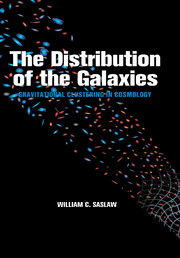Book contents
- Frontmatter
- Contents
- Prologue
- Part I Historical
- Part II Descriptions of Clustering
- Part III Gravity and Correlation Functions
- 16 The Growth of Correlations: I. A Fluid Description
- 17 The Growth of Correlations: II. A Particle Description
- 18 General Correlation Properties
- 19 Computer Simulations
- 20 Simulations and Observations of Two-Particle Correlations
- Part IV Gravity and Distribution Functions
- Part V Computer Experiments for Distribution Functions
- Part VI Observations of Distribution Functions
- Part VII Future Unfoldings
- Bibliography
- Index
18 - General Correlation Properties
Published online by Cambridge University Press: 19 January 2010
- Frontmatter
- Contents
- Prologue
- Part I Historical
- Part II Descriptions of Clustering
- Part III Gravity and Correlation Functions
- 16 The Growth of Correlations: I. A Fluid Description
- 17 The Growth of Correlations: II. A Particle Description
- 18 General Correlation Properties
- 19 Computer Simulations
- 20 Simulations and Observations of Two-Particle Correlations
- Part IV Gravity and Distribution Functions
- Part V Computer Experiments for Distribution Functions
- Part VI Observations of Distribution Functions
- Part VII Future Unfoldings
- Bibliography
- Index
Summary
Would it not be better to get something done even
though one might not quite understand what?
J. SyngeApparent confusion is a product of good order.
Sun TzuDespite difficulties in solving the BBGKY kinetic equations directly, judicious approximations give valuable insights into their physical properties. As soon as the system leaves the linear regime, these approximations replace a more rigorous analysis. Computer simulations, although they require further approximations, can tell if these insights are genuine and provide a useful description. In this chapter we discuss several physical approximations; following chapters summarize simulations and observations.
Scaling
Scaling has acquired many meanings in different contexts of large-scale structure and thereby caused some confusion. One form of scaling is the simple geometric relation between angular correlation functions W(θ) in catalogs of various limiting magnitudes, given by (14.38). This is closely related to the manufacture of catalogs rather than to the underlying dynamics of clustering. We mention it further in Chapter 20. A more physical form of scaling results from noticing that the Ω0 = 1 Einstein–de Sitter cosmology contains no scale length. Nor is there any scale length in the Newtonian gravitational force between galaxies. Therefore, the argument goes, correlation functions should not contain any scale lengths either and should be power laws.
Unfortunately this argument neglects the actual dynamical development of correlations. Initially, if the positions of newly formed galaxies are not correlated in a gravitationally self-consistent way on all scales, gravitational interactions of galaxies will tend to produce self-consistent correlations.
- Type
- Chapter
- Information
- The Distribution of the GalaxiesGravitational Clustering in Cosmology, pp. 216 - 226Publisher: Cambridge University PressPrint publication year: 1999



